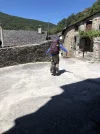Having walked six caminos and shared the senda with cyclists, I am of the opinion that, where there is a road alternative, bicycles should stick to the road. Presently, I am planning my first post-Covid Camino since 2019.
My thought is to do the entire Camino Via de la Plata (1,050 km) - using the mostly parallel N-630 carretera. This route was superseded by a nearby autopista (A-66 - A-52) route some years ago. The A-52 bit, replaces using the foot path on the Sanabres portion of the Camino in Galicia.
The N-630 has very wide verges / shoulders, reduced speed limits and more gentle grades than one would find on any hiking path. These roads were originally engineered to accommodate heavy trucks and construction equipment with small-ish engines and lots of gears. They remain in good repair and support mostly local traffic. Most, all of the heavy traffic, that is the greatest risk to a cyclist has been shifted to the limited entry autopistas.
This alternative is featured in bicycle guide books and on bicycle web sites about the VDLP. The route also intersects most of the towns and cities walking pilgrims frequent along this route. Riding a bicycle, one generally covers about three-times the distance daily. While you will not see the same walking pilgrims each evening, you will encounter walking pilgrims daily.
One final point. In many cases the road actually covers the original Roman road that originally formed the basis for the earliest Camino travelers. This progression of paving 'cowpaths' or dirt roads exists all over the world.
The modern Camino routes are largely established using nearby secondary or tertiary roads or farm sendas (trails or paths), with permission of the landowners. If you consult a map of Roman roads in Spain, you will see that most every major Camino path is laid out on top of the former Roman road location.
This is not categorical. I have walked many routes where the former Roman road is no where near the modern day Camino. However, many portions of the Spanish national roadway (carretera) system are built atop the original Roman routes.
The N-630 is one good example. Another good example is the N-120 and N-550 intertwined with the
Camino Frances.
Just some thoughts. Hope it helps the discussion. For a cyclist, it is food for thought, as remaining on the paved carretera system - where viable and safe - is likely a more historic route. THAT is an opinion.
Tom





















